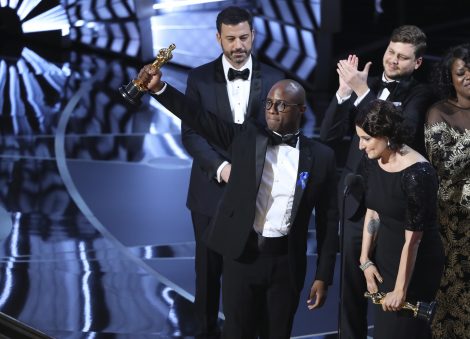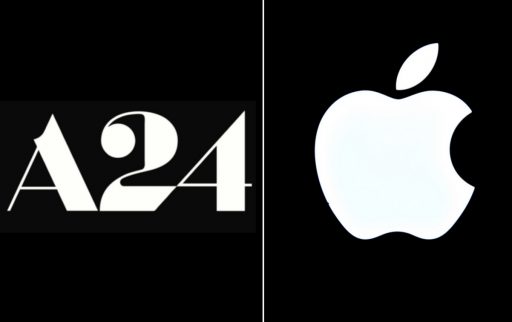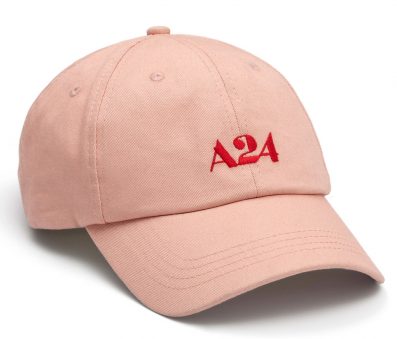At the 89th Academy Awards La La Land (2016), an ode to the classic Hollywood musical and “love letter to a mythical Los Angeles” (Wilkinson) was mistakenly announced as the Best Picture Award winner. Rather, it was Moonlight (2016) that won the coveted award, as well as three others (Fig. 1). Moonlight is representative of ‘a promising counter-cinema’ and ‘arguably the most successful black cast film in US history to date, critically and commercially’ (Sexton). It was also the first film financed entirely by film company A24 and marked their triumphant transition from indie distributor to full-fledged art house studio (Rao). This company – A24 – is the subject of this short guide.

A24 is an independent film company established in 2012 by Daniel Katz, David Fenkel and John Hodges. With backgrounds in film financing, production, and distribution, they used seed funding from Katz’s previous company, Guggenheim Partners, to start a company with a commitment to making films with “a distinctive point of view” (Doster). Far from the reaches of Hollywood, A24 operates out of a small office in New York. Unhindered by studio notes and meddling executives, the independent film company has grown in its eight years of operation into a place for auteur-directors and risk-taking Hollywood stars to make small-scale, unconventional movies. A24 started out by obtaining the distribution rights to independent films from film festivals before moving in to producing original films, television shows and other media, including podcasts, blogs, zines and merchandise. They have grown from having released five films in 2013, to releasing 20 films in 2019. A24’s films frequently top critics year end lists (Schager) and they’ve amassed a core group of dedicated fans, who frequent social media pages and forums dedicated to the company.
Unlike some independent film companies such as Blumhouse Productions, A24 don’t work solely within one genre. However, their horror output is key to their financial good health and has garnered acclaim. Horror is a very profitable genre based on return on investment (Ward). By working with fledgling horror auteurs like Ari Aster and Robert Eggers, and distributing films like Under the Skin (2013), Ghost Story (2017) and It Comes At Night (2017), A24 have defined what Steve Rose at The Guardian calls ‘post-horror’. This term is used to define a burgeoning sub-genre more focused on ‘metaphysical questions’ than monsters, gore, and jump scares. Rose makes a distinction between today’s ‘post-horror’ and critically lauded auteur-driven horror like Rosemary’s Baby (1968), The Shining (1980), and Don’t Look Now (1973), based on their non-studio production and lower budgets. Whilst not the sole focus of A24’s output, their horror films have helped them to net a core following within the horror fanbase.
A24’s independent sensibility and genre-fare has placed them alongside a number of new independent film companies. But there are key differences. Blumhouse, for example, distribute low-budget horror films and employ a technique wherein one hit film will cover losses of the others distributed (Webb). However, Blumhouse has been limited by its first-look deal with Universal and insistence on very low-budgets. In contrast, A24 have not relinquished their creative control to a larger studio and continue to focus on a more diverse range of (often avowedly political) mid-budget films with established names; the films actively seek critical and award recognition.
Further comparisons have been drawn with Annapurna Pictures, Neon, and BH Tilt, a subsidiary of Blumhouse. These companies, however, are largely limited by their budgets to only releasing a few films a year. As such, they tend to release their films in anticipation of the Awards season to draw further publicity by potentially netting a major award. A24, however, put out their annual slate of films throughout the year, thus having a consistent presence. This hasn’t detracted from A24’s success with awards: as of 2019, the company has received 25 Academy Award nominations.

As video-on-demand and streaming media became increasingly popular through the 2010s, A24 ensured they used this to help distribute their films. In their first year of operation, they entered a deal with Amazon Prime wherein A24-distributed films would be available on Amazon’s streaming service after becoming available on DVD and Blu-Ray. In 2018, A24 signed a multi-year partnership with Apple to produce a slate of original films for Apple+ (Fig. 2). Further, Uncut Gems (2019), A24’s highest-grossing film so far, was promptly released on Netflix International following its US debut. A 2018 PwC report found that 87 per cent of 18-24 year olds and 90 per cent of 25-34 year olds watch streaming video. As per this study, 25-34 year olds (millennials) have consistently been the largest age group to access television content via the Internet (PwC). A 2019 study found that the majority of streamers are single (58 per cent), 78 per cent live in urban or suburban areas, and 50 per cent have some level of college education (whilst the US average is 39 per cent) (Ewing). A24’s strategy of releasing their films on streaming services alongside their physical release ensures that a key part of their target demographic, millennials, have easy access to and can engage with their films. A24’s deals with Amazon, Apple and Netflix reveal this forward-thinking approach to film distribution.
One of the considerable risks A24 have taken is to make their film’s readily available on streaming services, thereby reducing box office sales. However, their bet appears to have paid off: the growing popularity of streaming services (especially following the Covid-19 pandemic) continues to make box office sales less significant (Whitten). Additionally, having their entire catalogue released promptly on Amazon Prime functions as an effective form of advertising: by allowing individuals who were unlikely to pay the cinema ticket price to see their films at a reduced price, A24 has managed to establish a following of technology-literate young people.
Recognising and engaging with this demographic of technology-literate young audiences has been critical to A24’s success. Before they became an established media brand, A24 drew public interest through seemingly controversial and incendiary marketing tactics. In 2013, they released five films directed by Roman Coppola, Sofia Coppola, Sally Potter, and Harmony Korine. Acclaimed directorial names aside, it was Spring Breakers (2013) that drove a lot of early publicity for the then-new company. Spring Breakers featured former-Disney child actors Selena Gomez and Vanessa Hudgens, Spider-Man star James Franco engaging in sexually explicit scenes and scenes of drug abuse alongside rapper Gucci Mane (who was then facing battery, assault, and weapons charges). Cinemagoers, particularly millennials, would have grown up watching these performers appearing in Disney and superhero programming. Marketing materials leaned heavily into Spring Breakers risqué content and its trailer, which was followed by clickbait articles, went viral thus generating anticipation for the film. Following Spring Breakers release, A24 launched an Academy Award Campaign for James Franco: ‘James Franco – Consider This Sh*t’. Whilst Spring Breakers divided critics, its content was incendiary enough to drive box office sales and recognition for the company behind its release, A24.
Whilst Spring Breakers publicity was driven by its arousing content and context, A24’s approach to the debut of Ex Machina (2015) was targeted guerrilla digital marketing. Ahead of the film’s premiere at South by Southwest (SXSW) 2015, A24 set up a Tinder bot to drive engagement with the film’s promotional materials. Recognising the festival’s core demographic as technology engaged single, young men, A24 used an old headshot of Ex Machina’s star, Alicia Vikander, to front a Tinder bot. When matched, the Tinder bot would initiate a philosophical conversation with the user before forwarding them a link to the film’s Instagram page. Whilst this corporate catfishing was duplicitous, it engaged directly with A24’s target market and subsequently drove up word of mouth and anticipation for Ex Machina’s wider release.
Rather than the typical approach of using social media as a tool to distribute marketing materials, A24 engage with the film communities on their respective channels. They have accounts on the expected Twitter and Facebook, but also regularly use their Instagram, Tumblr, Snapchat, LinkedIn, and Pinterest accounts and create custom content for each platform. Their social media strategy’s effectiveness has been commended since 2013, with attention focused on their Twitter feed as ‘a constant stream of hilarious and bizarre pop-culture and technology jokes’ (Lazauskas). A24 have also recognised the real economic benefits of curating an engaging online brand. Foregoing television slots for trailers and magazine spreads they have instead utilised the internet and social media to target younger, technology-literate demographics: cutting costs whilst engaging with millennial cinemagoers.
Beyond social media feeds, A24 generate discussion surrounding their films with multimedia projects and merchandising. In February 2018, they launched The A24 Podcast; a podcast series with each episode as a discussion between two individuals within the film industry. These discussions have featured stalwart Hollywood figures such as Martin Scorsese and Paul Thomas Andersen, A24 frequent collaborators like the Safdie brothers, Ari Aster, and Robert Eggers, and other figures like composer Daniel Lopatin and comedian Ramy Youssef. The tag-line of this podcast is ‘A24 in your eardrums. No host, no ads, no rules.’ (A24); it’s a polished podcast with high-profile star power. A 2020 study revealed that 48 per cent of US podcast listeners are between 12 and 34 years old, that they tend to be from wealthier households and are more likely to have a college degree (Winn). As with their use of streaming services, A24 have managed to target millennial and Generation Z cinemagoers with their podcast. Content lifted from the podcast is then repurposed into articles and lists for their website, playlists on Spotify, and video clips on YouTube.

On the A24 website, alongside blogs, podcasts, and videos, they host a web store (Fig. 3). The merchandise they sell includes limited edition DVDS, desktop wallpapers, A24-branded clothing and accessories and absurd products (an exclusive gold-plated Furby pendant from Uncut Gems (2019) and a $40 Climax (2019) VHS videotape are among the offerings). Their proclivity for lifestyle products is apparent in their logo adorned clothing range, screenplay coffee-table style books ($60 each) and genre-scented candles ($48 each) which includes scents like horror, western, sci-fi, and rom-com. These offerings have gained much attention, with one article noting that ‘A24, the world’s hottest film company, is making movie merch cool’ (Allen). This heavy merchandising has helped to turn A24 from a film distribution company into a recognisable and established brand. Today, stalwart fans of A24 can buy into it as a lifestyle with its products. Indeed, they have; as of April 2020, A24 Film Group an unofficial Facebook group for fans of A24 films, has over 31,000 members whilst another, A24 film memes, boasts over 2,000. Similarly, the A24 subreddit has over 27,000 members and boasts of itself as a ‘film community for the A24 worshippers, the casual fans, and everyone in between’ (Reddit).
A24’s rise to prominence is remarkable considering that it has grown out of an environment that has seemed hostile to independent film companies. In the early 1990s there was an independent film boom in America. Miramax, Focus Features, Fox Searchlight and Paramount Vantage grew out of a highly profitable film market in the 1990s but had largely ceased to operate by the mid-to-late 2000s. As they grew rapidly and without restraint, these companies either outgrew their independent sensibilities, or were deemed non-profitable and subsumed into their parent companies (Desta). Like many other industries, the remaining companies were crippled in the 2008 Global Recession, from which they have not recovered.
A24’s position as an alternative to mainstream Hollywood studio production is undeniable. Through targeted digital marketing and multimedia approaches to distribution they have successfully tapped into the zeitgeist and gained a following largely made up of millennial and Generation Z cinemagoers. As with the 1990s independent cinema boom, the company’s continual growth may prove to be their undoing. The A24 release schedule’s year-on-year growth may eventually be overshadowed by their own left-field merchandising and digital marketing techniques. Or, by relying on a core group of followers, they may grow complacent and stale in their film output. Whilst A24’s distance from Hollywood and independence from larger film studios may prove to be a double-edged sword, their steadfast commitment to independent filmmaking remains a bastion of hope for the independent American film industry as it faces threats from digital media production and online streaming.
References
A24. “The A24 Podcast”. Anchor.fm. Web. 24 Apr. 2020.
Allen, Ben. “A24, the World’s Hottest Film Company, Is Making Movie Merch Cool”. GQ-Magazine.co.uk. 7 Feb 2020. Web. 24 Apr. 2020.
Desta, Yohana. “Is A24, the Indie Upstart with a Fresh Best-Picture Win, the Next Miramax?”. Vanityfair.com. 28 Feb 2017. Web. 24 Apr. 2020.
Doster, Adam. “Upstart Distributor A24 is Making Indie Films Exciting Again”. Fastcompany.com. 11 Jan 2016. Web. 24 Apr. 2020.
Ewing, Jeff. “New Research Highlights Streaming Demographic Trends”. Forbes.com. 12 Feb. 2019. Web. 24 Apr. 2020.
Lazauskas, Joe. “Revealing A24’s Mystery Social Media Strategy Genius and All Her Secrets”. Contently.com. 30 Sep. 2013. Web. 24 Apr 2020.
PwC. “Consumer Intelligence Series: I Stream, You Stream”. Pwc.com. Web. 24 Apr. 2020.
Rao, Sonia. “How the Indie Studio Behind ‘Moonlight,’ ‘Lady Bird’ and ‘Hereditary’ Flourished While Breaking Hollywood Rules”. Washingtonpost.com. 5 Aug. 2019. Web. 12 Jun. 2020.
Reddit. Sidebar, r/A24. Web. 24 Apr. 2020.
Rose, Steve. “How Post-Horror Movies are Taking Over Cinema”. Theguardian.com. 6 Jul. 2017. Web. 24 Apr. 2020.
Ross, Winn. “2020 Podcast Stats & Facts”. Podcastinsights.com. 21 Apr 2020. Web. 24 Apr. 2020.
Schager, Nick. “The Best Movies of 2019”. Esquire.com. 18 Dec. 2019. Web. 24 Apr. 2020.
Sexton, Jared. 2017. Black Masculinity and the Cinema of Policing. London: Palgrave Macmillan.
Ward, Alvin. Taylor, Horne. “The 35 Most Profitable Movies of All Time, Based on Return on Investment”. Mentalfloss.com. 20 Sep. 2015. Web. 24 Apr. 2020.
Webb, Paul. “Mapping Contemporary Cinema – Short guide to Blumhouse Productions”. Mcc.sllf.qmul.ac.uk. Web. 24 Apr. 2020.
Whitten, Sarah. “Netflix isn’t Killing Movie Theaters: Viewers Who Stream More Also Go To Cinemas ore”. Cnbc.com. 8 Apr. 2019. Web. 24 Apr. 2020.
Wilkinson, Alissa. “La La Land sees Old Hollywood Magic Giving Way to Modern Melancholy”. Vox.com. 29 Dec. 2016. Web. 24 Apr. 2020.
Written by Guy Edbrooke Pullen (2020); Queen Mary, University of London
This article may be used free of charge. Please obtain permission before redistributing. Selling without prior written consent is prohibited. In all cases this notice must remain intact.
Copyright ©2020 Guy Edbrooke Pullen/Mapping Contemporary Cinema
 Print This Post
Print This Post

